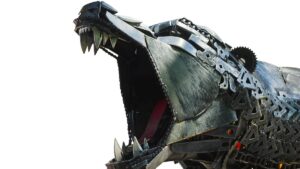The scale of this ASX iron ore junior’s mega project will blow you away

This ASX iron ore junior is angling for giant JV partner Vale to develop a multi-billion dollar mega mine. Pic: Getty Images
- Iron ore markets are short on the high grade iron ore needed for green steelmaking technologies
- High capital costs mean most large scale magnetite operations are helmed by majors
- But Cyclone Metals and Vale’s partnership on Canada’s 25Mtpa Iron Bear proposal puts at least one mega deposit with real potential in the hands of a speculative ASX junior
Iron ore markets have been unkind to junior players since the end of the 2021 boom.
While majors continue to print substantial, if dwindling, profits, the high costs across the small end of the iron ore market have seen speculative investor sentiment turn to more familiar markets like gold and copper.
According to BHP, the world’s largest miner, some 180Mt of the roughly 1.5Bt traded on the seaborne market globally now comes at marginal cost, 60% of that costing above US$90/t – the recent trampoline price for the steelmaking commodity.
With 62% Fe iron ore prices hovering between US$90-100/t and highly dependent on the health of a Chinese economy crying out for stimulus, it’s not a world for the small or feint of heart.
But look beyond a short-term sugar hit and there remain junior iron ore players who, at current prices, are sitting on figurative gold mines.
Today, we’re taking a look at one junior exploration and development company which has put its paws on an asset of the scale normally reserved for the biggest dogs in the yard.
It may come as a surprise to investors that one of the world’s largest untapped high grade iron ore deposits is sitting in a well-supported ASX micro-cap priced at a discount to short life gold tiddlers.
Cyclone ready to hit
Make no bones about it, Cyclone’s Iron Bear deposit near Schefferville in Quebec is a monster, coming in at a JORC resource of 16.6Bt at 29.9% Fe.
That may seem low in grade when you compare it to the hematite deposits of the Pilbara, where BHP, Rio Tinto and Fortescue ship hundreds of millions of tonnes a year grading around 60-62% Fe.
But the secret is in the mineralogy. Naturally magnetic, magnetite carries the chemical formula Fe3O4 – hematite is Fe2O3.
Those small numerical differences make for big changes in the way the ore is composed. Magnetite exists in far lower iron concentrations in the ground.
But once beneficiated it can run to much higher grades of 65% to 68%, even as high as the low 70s. Despite years of studies, miners and steelmakers are yet to find a way to upgrade hematite to those levels.
The other key aspect of high quality magnetite concentrates is their low silica levels. This is key, since the steelmaking process these materials are geared towards – unlike the conventional blast furnace – do not generate slag.
That means impurities must be dealt with before the process of reducing iron ore to steel begins.
But there is a catch. These deposits are hard to find, especially with the right metallurgical properties. Only ~125Mt of the 1.5Bt of iron ore exported each year is high enough in grade and low enough in impurities to feed direct reduced iron steelmaking, which runs at a quarter of the CO2 emissions as blast furnaces.
Yet Wood Mackenzie projects in a 1.5C scenario, as much as 750Mtpa will need to come from these sources – barely fathomable.
That’s a mismatch in supply and demand that will work wonders for projects like Iron Bear, which will expect to draw increasing premiums over the benchmark fines price.
Iron Bear
Here’s how Iron Bear shapes up.
This month’s scoping study suggested at a conservative iron ore price of US$90/t (62% Fe benchmark), a US$4.64bn construction project would deliver a project producing 25Mtpa for 18 years.
That seems like a lot of dosh, until you factor in that the world’s largest high grade iron ore producer, Brazil’s Vale, is footing the bill for studies to the tune of US$138m, and would take a 75% stake on development if the final numbers stack up.
That project, which would generate 16Mtpa of blast furnace concentrate and 9Mtpa of direct reduction pellets, would run at an FOB operating cost of US$46.1/t for the blast furnace product and US$67.8/t for DR pellets, helped by an attractive 0.34:1 life of mine stripping ratio.
Metallurgical testwork has already shown the working there.
Blast furnace concentrates have been produced from Iron Bear samples grading 69.8% Fe and 3.4% silica.
A direct reduction concentrate grading 71% Fe and 1.1% silica, well within impurity requirements for DRI mills, has also been produced along with DR pellets with a cold compression strength of 346kg.
The DR pellets are expected to be fetching prices in excess of US$200/t from the start of operations, more than double the prevailing benchmark price.
A PFS has already been commissioned for completion by mid-2026, with the project already holding a post-tax NPV of US$9.8bn and IRR of 18.6%.
Power supply is often a major concern with magnetite operations, but Cyclone has already flagged the potential to access cheap, 100% renewable power via a combination of local hydro and wind resources.
Hidden gem
Cyclone Metals (ASX:CLE) runs at a market cap of just $67.51m. Even if 75% of the project’s base case US$9.8bn NPV is assigned to Vale, which will build and operate the mine if the agreement is consummated to its fullest potential, a quarter of the NPV outstrips CLE’s market value 36 times over.
If it all goes to plan, that leverage is enormous.
By way of comparison, Champion Iron’s Kami project, which is being backed by Japanese state steel and trading companies and is also located in the Labrador Trough, has a NPV ranging from US$541m-2.2bn. But it’s already a $2.23bn company with a history of production.
CIA’s shares run at $4.19, having already charged more than 4500% from their lows in the iron ore downturn.
Cyclone’s are fetching 6.5c, indicating the size of the prize if Vale can progress the Iron Bear asset.
Kami will run at a production rate of 9Mtpa on capex of US$2.46bn or $3.8bn, a capital intensity of around US$273.66/t.
On its scoping study numbers, Iron Bear could come in at US$185.6/t, comparing favourably to similarly sized projects.
Fortescue’s 22Mtpa Iron Bridge (still being ramped up to its full scale after some early teething issues) clocked in at around US$177/t, assuming it gets up to nameplate.
While magnetite is the dominant source of iron ore domestically in China, there are only a handful of export operations of genuine scale.
One is Iron Bridge, another is the Samarco JV in Brazil co-owned by BHP and Vale (26-27Mtpa at full capacity).
Then there’s CITIC’s Sino Iron in WA (21Mtpa), Rio Tinto’s Iron Ore Company of Canada (23Mtpa fines/12.5Mtpa pellets) and Champion Iron’s Bloom Lake (15Mtpa).
That places Iron Bear in an elite group, pending further studies.
Other major producers are often found in less than stable jurisdictions like Russia and Ukraine.
At Stockhead, we tell it like it is. While Cyclone Metals is a Stockhead advertiser, it did not sponsor this article.
Related Topics
UNLOCK INSIGHTS
Discover the untold stories of emerging ASX stocks.
Daily news and expert analysis, it's free to subscribe.
By proceeding, you confirm you understand that we handle personal information in accordance with our Privacy Policy.








